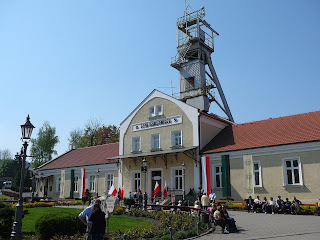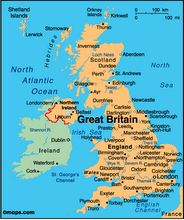 Sunday
SundayOn Sunday morning we had breakfast at our hotel and then caught a train out to Wieliczka. Wieliczka is a small town about 12km south-east of Krakow, famous for its massive salt mine. Until 2007, the Wieliczka salt mine had been producing table salt in continuous operation since the 13th century, making it one of the oldest operating salt mines in the world. Active mining ceased due to low salt prices and mine flooding. The mine remains a major tourist attraction.
The mine reaches a depth of 327m and the passages, halls and stairways combine to 300km in distance. It appears that miners kept themselves amused not only by extracting salt, but also by carving hundreds of sculptures and statues of historic and mythic figures. The older works in the mine were sculpted by miners out of rock salt; more recent figures have been fashioned by contemporary artists. The rock salt is naturally grey, in various shades like granite, so that the carvings resemble carved unpolished granite rather than having the white or crystalline appearance that many visitors expect.
The two-hour tour of the mine that we took covered 3km, less than 1% of the mine's passages. We visited three different levels of the mine between 90m and 130m below ground. The tour follows museum exhibits showing how the salt mine used to operate centuries ago and how technology changed over time to make mining easier. It also features many of the carved statues, a restaurant and an underground lake along the way.
The highlight of the tour, however, is the huge underground chapel, St Kinga's Chapel, carved completely from rock salt. It was laid out in 1896, in the space created after the excavation of a huge green salt block. It is over 54 metres long, 15-18 metres wide and 10-12 metres high. The chapel was created, mainly by three miners, over a period of almost 70 years up until 1963. The chapel features a magnificent alter, a Christmas crib, a statue of Pope John Paul II, biblical scenes carved into the walls and beautiful chandeliers made from salt crystals.
After the tour of the salt mine we caught a bus back in to Krakow and had kebabs for lunch in the square. Sunday was a public holiday in Poland so there was plenty of entertainment in the Old Town and it was another warm, sunny day. After lunch we wandered south of the Old Town to Kazimierz, the Jewish district.
Kazimierz was originally a separate town from Krakow. After King Jan Olbracht moved the Jewish population out of Krakow to Kazimierz in the late 15th century, the separate nature of Kazimierz became more pronounced. The town soon became a leading centre of Jewish culture. Although it was integrated administratively into Krakow in 1791, the distinctive character of the quarter is still evident today. Kazimierz was home to Krakow's 60,000-plus Jewish population until WWII. Today it is a peaceful and pretty area with markets, cafes and shops scattered between synagogues and other Jewish sites.
We visited the Remuh Synagogue and Remuh Cemetery. The Remuh Cemetery was established in 1535. In 1800 the cemetery was closed and a nearby New Jewish Cemetery was built. It is one of the very few Jewish cemeteries in Europe with such a large number of tombs and sarcophagi.
The cemetery was almost entirely destroyed by Nazis during WWII, who tore down the walls and sold tombstones for use as paving stones. However, the tomb of Remuh, which still attracts pilgrims from all over the world, was one of the few to survive. Many other tombs were excavated after WWII and it is thought that these had been buried during the Swedish invasion in the early 18th century. The cemetery has undergone a series of post-war restorations, including the construction of the Wailing Wall by the entrance to the cemetery, which was made using fragments of tombstones destroyed during the war.
It was very peaceful and quiet in the cemetery and throughout the Kazimierz district actually. We leisurely walked back around the Old Town through the Planty gardens, which provided welcome shade on another hot afternoon. We rested at the hotel for a couple of hours and tried out some of the local Polish beers, Tyskie and Zywiec, both of which were very nice.
In the evening we returned to the square and had a drink at Grill 15/16 - it was a stunning evening and the light on the old buildings around the square looked fantastic as the sun was setting. We went back to CK Browar for dinner, as we had enjoyed it so much the night before. It was pretty full and lively again. The food was delicious and quite cheap too. We decided to check out a jazz bar on the way back to the hotel, but there were just two people in there and they were both staff, so we snuck out again.
Monday
On Monday morning we had booked in to a half-day tour to the Auschwitz concentration camps. Auschwitz-Birkenau was the largest of Nazi Germany's concentration and extermination camps, established in Nazi German occupied Poland. The camp took its name from the nearby Polish town of Oswiecim, about 50km south-west of Krakow. Following the German invasion of Poland in September 1939, Oswiecim was annexed by Nazi Germany and renamed Auschwitz, the town's German name.
It is thought that around 1.1 million people died at Auschwitz, about 90 percent of whom were Jews from almost every country in Europe. Most victims were killed in Auschwitz II's gas chambers using Zyklon B; other deaths were caused by systematic starvation, forced labour, lack of disease control, individual executions, and purported "medical experiments".
The three main camps were Auschwitz I, II, and III. Auschwitz I, the original concentration camp, served as the administrative centre for the whole complex, and was the site of the deaths of roughly 70,000 people, mostly ethnic Poles and Soviet prisoners of war. Auschwitz II (Birkenau) was an extermination camp and was the site of the deaths of at least 960,000 Jews, 75,000 Poles, and 19,000 Gypsies. Birkenau was the largest of all the Nazi extermination camps. Auschwitz III (Monowitz) served as a labour camp.
Auschwitz I was opened in June 1940 and the camps were liberated by Soviet troops in January 1945. In 1947, in remembrance of the victims, Poland founded a museum at the site of the Auschwitz I concentration camp. By 1994, 22 million visitors (700,000 annually) had visited the museum.
We boarded our tour bus at 8am and during the journey to Auschwitz, we were shown a video about the liberation of the camps. We started at the Auschwitz I site, with a two-hour guided tour of the memorial museum and then we went over to Auschwitz II (Birkenau) for around 40 minutes. The museum is very well presented and our tour guide was excellent. Needless to say we were shocked and horrified by what we saw and heard during the tour and at times we both felt physically sick.
Back in Krakow we grabbed some lunch and looked around the shops in the Old Town. We enjoyed sitting on the steps of the huge Mickiewicz statue in the square, soaking up some sun and people-watching. Tim also had another look through some of the stalls and craft shops in Cloth Hall. Then we wandered back down Grodska to have a look inside the Church of Saints Peter and Paul.
The Church of Saints Peter and Paul is yet another wonderfully decorated Roman Catholic church in the Old Town of Krakow. The church was constructed between 1596 and 1605. On the wall in front of the church are 12 statues, one of each of the 12 Apostles. While not quite as stunning as the Church of St Mary, the high alter and several statues and paintings make this church beautiful and it is definitely worth a look.
Later in the afternoon we went to Pod Wawelem, a fantastic Bavarian beer house / restaurant, on the edge of the Planty gardens at the base of Wawel Hill. The restaurant was great - the food and the beer were brilliant and there was a really good atmosphere in the place. They have a big outdoor seating space in front of the restaurant and they also have a fun old-fashioned beer truck parked in front of the restaurant (photo below). We had a very tasty dinner there before heading off to the airport.
Tim noticed in the men's toilets that they had two big trough-like tubs with a hose in each that had been designed for people to throw up in. They actually had a picture above the troughs of a cartoon man throwing up, so that people would know what they were there for! While poor form that these would be needed, they are actually a very good idea for keeping the rest of the toilet clean and would come in very handy in a place like Dunedin!
Wieliczka
Salt Mine
90m
under
ground -
Salt Mine
St Kinga's
Chapel -
Salt Mine
Megs in
St Kinga's
Chapel
Remuh
Cemetery
Wailing
Wall -
Remuh
Cemetery
Kazimierz
Pod
Wawelem
Gate at
Auschwitz I
Roll call
square
"Wall of
Death"
Barracks
Auschwitz I
Main Gate -
Auschwitz II
Birkenau
Barracks -
Auschwitz II
Megan in
square
Mickiewicz
statue -
square
Cloth
Hall
Big beer























No comments:
Post a Comment